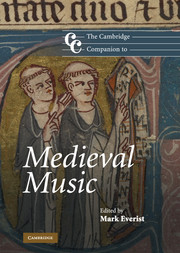4 - The thirteenth century
from Part I - Repertory, styles and techniques
Published online by Cambridge University Press: 28 September 2011
Summary
Scope and context
Garry Trudeau begins my favourite Doonesbury cartoon with three frames each bearing a date: (1) a hooded figure tries to escape a stoning: ‘1205 – A plague-stricken calligrapher is driven from Gunbad-I-Qabus’; (2) a mendicant fanatic prepares a burning at the stake: ‘1233 – A heretic perishes in Castile’; (3) a severed head hangs by its hair from the branch of a tree: ‘1276 – On the Malaysian archipelago, a gruesome trophy swings in a lagoon.’ The fourth frame cuts to Trudeau's ex-Hollywood starlet, Barbara Ann Boopstein, on a beach with a soda in her hand as she muses ‘Sometimes it seemed the 13th century would never end!’ To turn abruptly to the music of the thirteenth century – although calligraphers and mendicant fanatics have their place there – is to feel some sympathy with Boopsie's ruminations. Not only did the ‘long’ thirteenth century never quite seem to end, but its beginnings were not quite obvious either. And although no one ever seems to argue for a ‘short’ century, the claims for thinking about the music of the thirteenth century from around 1170 up to ca1320 are strong. The blurred distinction between versus and conductus is as much geographical as chronological (between north and south as much as early and late twelfth century), and the emergence of a consistent style of Parisian organa is usually assumed to fall somewhere in the last quarter of the twelfth century. Yet these are the staple genres of the thirteenth century, with works copied and recopied at least as late as 1300, and the motet – although probably not surfacing before 1200 – retains its links with the thirteenth century well into the fourteenth alongside works of what might be thought to represent the avant-garde.
- Type
- Chapter
- Information
- The Cambridge Companion to Medieval Music , pp. 67 - 86Publisher: Cambridge University PressPrint publication year: 2011
- 3
- Cited by



